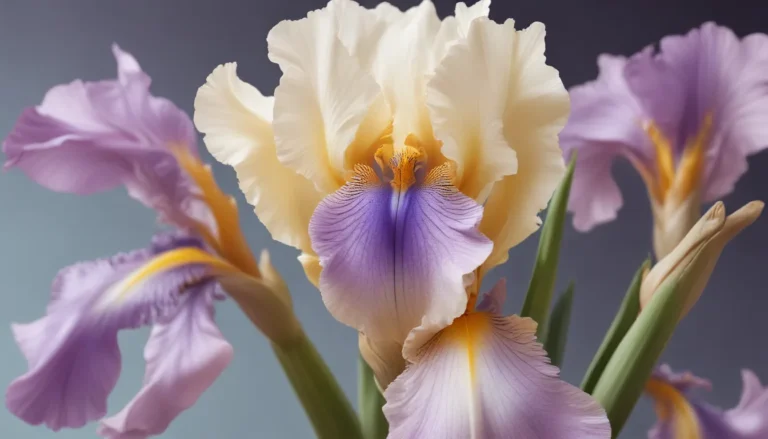The pictures we use in our articles might not show exactly what the words say. We choose these pictures to make you interested in reading more. The pictures work together with the words but don’t take their place. The words still tell you the important facts.
Welcome to the enchanting world of Spanish Moss, a captivating plant that graces trees with its ethereal beauty and mystique. As you dive into the depths of this intriguing epiphytic plant, you'll uncover a wealth of surprising facts that highlight its ecological importance and cultural significance. So, fasten your seatbelt and get ready for an awe-inspiring journey into the realm of Spanish Moss!
The Versatility of Spanish Moss
- Spanish Moss is not a true moss but a versatile epiphytic plant that hangs from trees and acts as a natural air purifier. It provides habitat for various organisms and serves as nesting material for birds. Despite its delicate appearance, Spanish Moss is durable and resilient, showcasing its fascinating and versatile nature.
The Epiphytic Marvel
Spanish Moss is an epiphytic plant that grows on other plants or structures for support but does not derive nutrients from them. This unique plant hangs gracefully from tree branches and gathers moisture and nutrients from the air and rain, creating a stunning display in any landscape it inhabits.
Not Your Average Moss
Contrary to its name, Spanish Moss is not a moss at all. It belongs to the bromeliad family and is related to pineapples and air plants. Its scientific name, Tillandsia usneoides, alludes to its resemblance to the Usnea lichen, adding to its mysterious charm and allure.
The Allure of Silvery Gray Beauty
Featuring long, thin, and delicate grayish-green stems that can grow up to 20 feet long, Spanish Moss exudes a soft and ethereal beauty that enchants all who behold it. Its graceful draping appearance adds a touch of elegance and mystery to the trees it adorns.
A Natural Air Filter
Spanish Moss plays a vital role in improving air quality by acting as a natural filter. It absorbs pollutants and dust particles from the air, making it beneficial for both humans and the environment. Its contribution to purifying the air highlights its essential ecological role.
A Microecosystem in the Canopy
Creating a unique microecosystem within its hanging colonies, Spanish Moss provides a habitat for a diverse array of organisms, including insects, spiders, birds, and small mammals. This biodiversity contributes to the overall health and balance of the ecosystem where Spanish Moss thrives.
Nesting Haven for Avian Friends
Many bird species, such as owls, wrens, and mockingbirds, utilize Spanish Moss as nesting material. The soft, fibrous strands of the plant offer a comfortable and secure environment for these birds to raise their young, highlighting the plant's importance in supporting wildlife.
A Plant with Medicinal Lore
With a long history of folk medicine use, Spanish Moss has been traditionally employed for treating various ailments, including rheumatism, fever, and childbirth complications. Its medicinal folklore adds another layer of intrigue to this fascinating plant's legacy.
Resilience in Fragility
Despite its delicate appearance, Spanish Moss is surprisingly durable and resilient. It can withstand harsh elements such as strong winds and drought, showcasing its ability to adapt and thrive in various climatic conditions. This resilience underscores the plant's strength and tenacity.
Slow and Steady Growth
Spanish Moss has a slow growth rate, adding only a few inches to its length each year. This gradual growth allows the plant to adapt and flourish over the long term, embodying a sense of patience and endurance that adds to its allure.
Embodiment of Southern Charm
Commonly associated with the southern United States, particularly states like Florida, Louisiana, and Georgia, Spanish Moss is often depicted in literature, artwork, and photographs as a symbol of the region's unique charm and natural beauty. Its presence evokes a sense of nostalgia and admiration for the landscapes it graces.
Cultural Tapestry of Spanish Moss
Spanish Moss holds cultural significance for various Native American tribes and the Gullah people of the southeastern United States. It has been utilized in traditional crafts, ceremonies, and symbolic rituals for generations, adding a rich layer of cultural heritage to its botanical legacy.
Practical and Diverse Uses
Throughout history, Spanish Moss has served a variety of practical purposes. From stuffing mattresses and pillows to acting as insulation and even a natural tinder for starting fires, the plant's versatility has been harnessed for an array of human needs, showcasing its adaptability and resourcefulness.
Soil-Free Survival
One of the most intriguing aspects of Spanish Moss is its ability to thrive without being rooted in soil. By obtaining all its necessary nutrients and moisture from the air, rain, and decaying plant matter, Spanish Moss exemplifies nature's ingenuity in adapting to diverse environments.
Unveiling the Mysteries of Spanish Moss
As you journey through the wonders of Spanish Moss, you'll discover a plant that transcends mere aesthetics to embody a tapestry of ecological, cultural, and practical significance. From its role in providing habitats for wildlife to its historical uses by indigenous communities, Spanish Moss weaves a narrative of resilience, beauty, and enchantment that captivates all who encounter it. Whether you're a nature enthusiast or simply appreciate the beauty of plants, Spanish Moss promises a world of discovery and wonder at every turn.
Frequently Asked Questions
-
What is Spanish Moss?
Spanish Moss (Tillandsia usneoides) is an epiphytic bromeliad that grows on trees and structures, absorbing nutrients and moisture from the air and rain. -
Where is Spanish Moss typically found?
Spanish Moss is native to the southeastern United States, including states like Florida, Louisiana, and Georgia, as well as parts of Mexico, Central America, and the Caribbean. -
How does Spanish Moss obtain nutrients?
Spanish Moss absorbs nutrients through specialized scales on its stems, drawing sustenance from the air, rain, and debris that falls onto the plant. -
Is Spanish Moss harmful to trees it grows on?
No, Spanish Moss is not harmful to host trees as it derives nutrients independently from the air and rain, using the host plant solely for support. -
Can Spanish Moss be grown indoors?
Yes, Spanish Moss can thrive indoors as a houseplant in high-humidity environments with indirect light, making it a versatile and low-maintenance addition to interior spaces. -
How does Spanish Moss reproduce?
Spanish Moss reproduces through small yellowish-green flowers that produce seeds dispersed by wind and animals, ensuring the plant's continued propagation. -
Is Spanish Moss used for practical purposes?
Yes, Spanish Moss has been historically used for manufacturing mattresses, pillows, and insulation, showcasing its versatility and utility beyond its ornamental value. -
Does Spanish Moss have cultural significance?
Spanish Moss holds cultural significance for Native American tribes and the Gullah people, who have integrated the plant into traditional crafts, ceremonies, and rituals for generations. -
Can Spanish Moss survive drought conditions?
Yes, Spanish Moss is highly resilient and can withstand drought by going into a dormant state until moisture returns, highlighting its adaptability to challenging environmental conditions. -
Is Spanish Moss easy to care for?
Spanish Moss requires minimal maintenance and thrives in high-humidity environments with indirect light, making it a relatively easy and rewarding plant to cultivate and enjoy.
Exploring the marvelous world of Spanish Moss has been a journey filled with wonder and discovery. As you embrace the enchantment of this captivating plant, may its beauty and resilience inspire you to appreciate the intricate tapestry of nature that surrounds us. Whether in a lush forest canopy or a cozy indoor space, Spanish Moss brings a touch of elegance and mystique that transcends mere botanical allure. So, keep exploring, keep learning, and continue to marvel at the wonders of the natural world that surrounds us.






